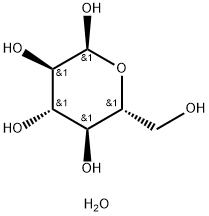D(+)-GLUCOSE MONOHYDRATE
Synonym(s):D- (+)-Glucose monohydrate;Dextrose;Dextrose monohydrate;Dextrosum (Glucosum) monohydricum
- CAS NO.:14431-43-7
- Empirical Formula: C6H14O7
- Molecular Weight: 198.17
- MDL number: MFCD00149450
- EINECS: 604-408-5
- SAFETY DATA SHEET (SDS)
- Update Date: 2025-07-14 15:27:00

What is D(+)-GLUCOSE MONOHYDRATE?
The Uses of D(+)-GLUCOSE MONOHYDRATE
D-(+)-Glucose monohydrate is used by industry professionals to indicate the degree to which a substance contains water, and in food industry, pharmaceuticals.
The Uses of D(+)-GLUCOSE MONOHYDRATE
D-(+)-Glucose monohydrate has been used as a test compound for studying its dehydration kinetics by using THz time-domain spectroscopy (THz-TDS).
What are the applications of Application
D-(+)-Glucose monohydrate is a common natural sugar involved in multiple cellular processes
General Description
D-(+)-Glucose monohydrate is a common natural sugar, and is involved in processes like glycosylation, energy production and formation of glycans that are involved in providing structure to the cells. D-(+)-Glucose monohydrate also causes glycation which is a detrimental process in cells. It is used as a supplement for numerous cellular processes and in cell culture.
Biochem/physiol Actions
Dextrose or glucose is an essential metabolite for brain and muscle cells. It is involved in majority of pathways and the levels are fined tuned by insulin hormone. Dextrose is majorly used in cell culture and high levels are detrimental, attenuating mesenchymal stem cell proliferation.
Properties of D(+)-GLUCOSE MONOHYDRATE
| Melting point: | 83°C |
| storage temp. | Store at +15°C to +25°C. |
| solubility | H2O: 1 M, clear, colorless |
| form | White powder |
| color | White to off-white |
| PH | 6-7 (100g/l, H2O, 20℃) |
| optical activity | [α]20/D +52.5 to +53.3°, c = 10% in H2O (calc. on anhydrous subst.) |
| Water Solubility | Soluble in water. |
| BRN | 5250278 |
| CAS DataBase Reference | 14431-43-7(CAS DataBase Reference) |
Safety information for D(+)-GLUCOSE MONOHYDRATE
| Signal word | Warning |
| Pictogram(s) |
 Exclamation Mark Irritant GHS07 |
| GHS Hazard Statements |
H302:Acute toxicity,oral H315:Skin corrosion/irritation H319:Serious eye damage/eye irritation H335:Specific target organ toxicity, single exposure;Respiratory tract irritation |
| Precautionary Statement Codes |
P261:Avoid breathing dust/fume/gas/mist/vapours/spray. P305+P351+P338:IF IN EYES: Rinse cautiously with water for several minutes. Remove contact lenses, if present and easy to do. Continuerinsing. |
Computed Descriptors for D(+)-GLUCOSE MONOHYDRATE
| InChIKey | SPFMQWBKVUQXJV-BTVCFUMJSA-N |
D(+)-GLUCOSE MONOHYDRATE manufacturer
Bazayan & Co.
New Products
4,4-Difluoropiperidine hydrochloride tert-butyl 9-methoxy-3-azaspiro[5.5]undecane-3-carboxylate Indole Methyl Resin N-Isopropylurea N,N-Dicyclohexylcarbodiimide(DCC) MELDRUMS ACID 5-METHYLISOXAZOLE-4-CARBOXYLIC ACID Magnessium Bis glycinate Zinc ascorbate 1-bromo-2-butyne 2-acetamidophenol 9(10H)-anthracenone Erythrosin B, 4-Piperidinopiperidine 2-((4-morpholinophenylamino) (methylthio) methylene) malononitrile 2,4-dihydroxybenzaldehyde 3-(4-morpholinophenylamino)-5-amino-1H-pyrazole-4-carbonitrile Methyl 2-methylquinoline-6-carboxylate 2,6-dichloro-4-nitropyridine 4-Bromo-2-chlorobenzonitrile 2-(benzylamino)acetic acid hydrochloride 4-(tert-Butoxycarbonylamino)but- 2-ynoic acid 3,4-dihydro-2H-benzo[b][1,4]dioxepine 1-Phenyl-1-cycloprppanecarboxylicacidRelated products of tetrahydrofuran








You may like
-
 Dextrose, monohydrate, GR CAS 14431-43-7View Details
Dextrose, monohydrate, GR CAS 14431-43-7View Details
14431-43-7 -
 Dextrose monohydrate, extra pure, 99%+ CAS 14431-43-7View Details
Dextrose monohydrate, extra pure, 99%+ CAS 14431-43-7View Details
14431-43-7 -
 D-(+)-Glucose monohydrate CAS 14431-43-7View Details
D-(+)-Glucose monohydrate CAS 14431-43-7View Details
14431-43-7 -
 Glucose Monohydrate PowderView Details
Glucose Monohydrate PowderView Details
77938-63-7 -
 3-(4-amino-1-oxoisoindolin-2-yl)-1-methylpiperidine-2,6-dione 98%View Details
3-(4-amino-1-oxoisoindolin-2-yl)-1-methylpiperidine-2,6-dione 98%View Details -
 20677-73-0 (2,2-diethoxyethyl)methylamine 98%View Details
20677-73-0 (2,2-diethoxyethyl)methylamine 98%View Details
20677-73-0 -
 3-(4-(hydroxyamino)-1-oxoisoindolin-2-yl)piperidine-2,6-dione 98%View Details
3-(4-(hydroxyamino)-1-oxoisoindolin-2-yl)piperidine-2,6-dione 98%View Details -
 57381-49-4 2-bromo-4-chlorobenzonitrile 98%View Details
57381-49-4 2-bromo-4-chlorobenzonitrile 98%View Details
57381-49-4
